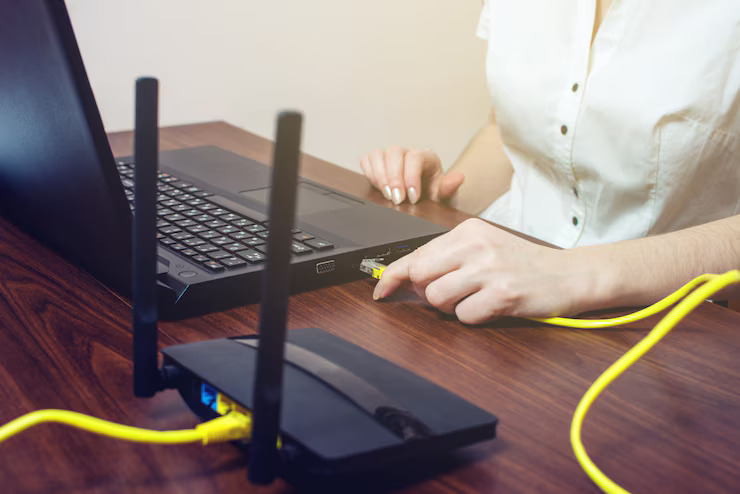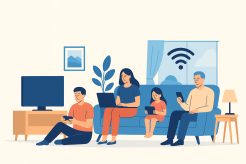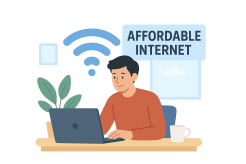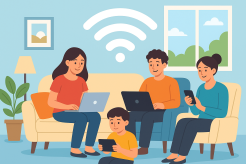Why Some Areas Still Don’t Have Fiber Internet

Fiber-optic internet offers unparalleled speed and reliability, yet many regions, especially rural areas, remain without access. This article explores the reasons behind this digital divide and provides insights into when fiber internet might become available in underserved areas.
Why Fiber Internet Isn't Everywhere
1. High Infrastructure Costs
Deploying fiber-optic cables requires significant investment. The process involves laying cables underground or on poles, which can be prohibitively expensive, particularly in areas with low population density. In some rural regions, the cost per household can exceed six figures, making it economically unfeasible for providers.
2. Low Population Density
Internet Service Providers (ISPs) prioritize areas where they can maximize returns. Sparse populations mean fewer customers to share the infrastructure costs, leading providers to focus on urban and suburban regions.
3. Regulatory and Logistical Challenges
Building out fiber networks involves navigating complex regulatory landscapes, obtaining permits, and coordinating with local authorities. These hurdles can delay or deter infrastructure projects, especially in areas with stringent regulations.
4. Existing Competition
In some locales, existing broadband services like cable or DSL offer sufficient speeds for most users. The presence of these services can reduce the demand for fiber, making ISPs hesitant to invest in new infrastructure.
5. Geographic and Environmental Barriers
Challenging terrains, such as mountains, forests, or bodies of water, can complicate the installation of fiber networks. These physical obstacles increase costs and technical difficulties.
When Might Fiber Internet Reach These Areas?
1. Government Initiatives and Funding
Governments are increasingly recognizing the importance of broadband access. Programs like the Broadband Equity, Access, and Deployment (BEAD) initiative allocate funds to expand internet infrastructure in underserved areas. Such initiatives aim to bridge the digital divide by subsidizing the cost of fiber deployment.
2. Public-Private Partnerships
Collaborations between governments and private companies can facilitate the expansion of fiber networks. By sharing costs and resources, these partnerships can make projects more viable in less profitable regions.
3. Technological Advancements
Innovations like micro-trenching and aerial fiber deployment reduce installation costs and time. As these technologies become more widespread, they can accelerate the rollout of fiber in challenging areas.
4. Community Advocacy
Local communities advocating for better internet access can influence ISPs and policymakers. Demonstrating demand and potential benefits can encourage investment in fiber infrastructure.
Alternatives While Waiting for Fiber
While awaiting fiber deployment, residents can explore other high-speed internet options:
Fixed Wireless Access (FWA): Utilizes radio signals to provide internet, suitable for areas where laying cables is impractical.
Satellite Internet: Services like Starlink offer broadband via satellites, reaching remote locations without traditional infrastructure.
DSL and Cable: Though not as fast as fiber, these technologies can suffice for basic internet needs.
For a detailed comparison of internet types, refer to this comprehensive guide on fiber vs. DSL vs. cable.
Understanding the Infrastructure
The choice between fiber-optic and copper cables significantly impacts internet performance. Fiber offers higher speeds and reliability but requires new infrastructure. Copper cables, used in DSL and traditional phone lines, are more widespread but have limitations. Learn more about the differences in this comparison of fiber-optic and copper cables.
Looking Ahead
The expansion of fiber internet is a complex process influenced by economic, regulatory, and technical factors. However, with ongoing efforts from governments, communities, and ISPs, the reach of fiber is steadily growing. For those eager to experience the benefits of fiber, staying informed and engaged with local initiatives is key.
To explore available fiber internet options in your area, visit our fiber internet providers page.
Related Posts

Fri, Nov 28, 2025 11:17 PM
cheap internet dealsThe Ultimate Guide to Internet Bandwidth
Learn how internet bandwidth works, how to optimize upload and download speeds, and get fast, reliable performance for your home network.

Fri, Nov 28, 2025 10:36 PM
cheap internet plansHow to Choose the Best Internet Plan Based on Your Household Size
Learn how to choose the best internet plan for your household size. Match speeds, connection types, and costs to your devices and daily usage for reliable home Wi-Fi.

Thu, Nov 27, 2025 1:22 AM
cheap internet offersInternet Subsidies: What They Cover and How to Benefit
Learn how to qualify for federal, state, and non-profit discounts and find the right cheap internet plan for your home.

Wed, Nov 26, 2025 4:22 AM
Internet BundlesWhy Upload Speed Matters: Choosing the Right Internet Plan
Discover why upload speed is just as important as download speed. Learn how to pick the right internet plan for streaming, video calls, and online gaming.

Wed, Nov 26, 2025 2:37 AM
Internet BundlesAffordable Internet Plans: Your Complete FAQ Guide
Discover affordable internet plans for students, low-income households, and families. Learn tips to save, available providers, and assistance programs like Lifeline.